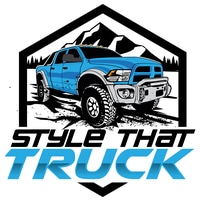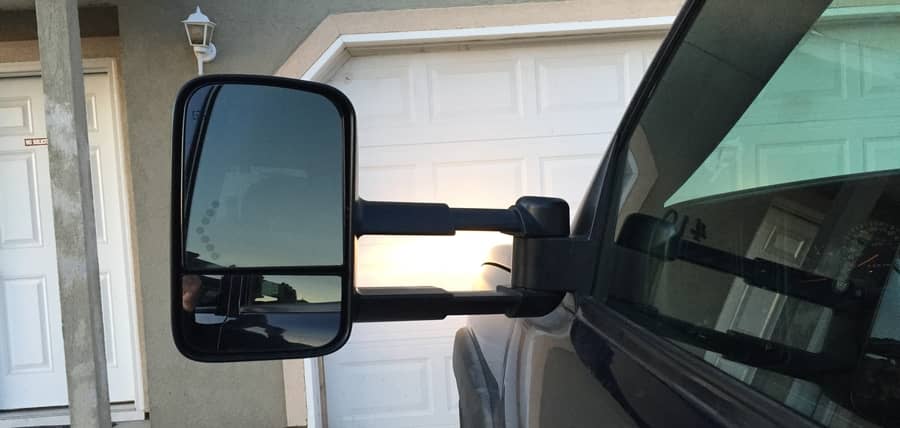
I love my trucks and like to have my mirrors adjusted for great visibility behind me for everyday driving. Often, though, when I hitch up a trailer, I realize that my ability to see what’s behind me is greatly inhibited using the standard mirrors found on many of my tow vehicles. Not only is this annoying or frustrating, it can be very dangerous too.
Why do you need towing mirrors when towing a trailer? Most trailers are wider than the vehicle towing them and are usually wider than the placement of standard mirrors that come on the majority of cars, trucks, & SUV’s. This creates blind spots beyond the edges of the wide trailer that standard mirrors cannot see, greatly reducing your field of vision as roughly illustrated in the first image below. Towing mirrors provide a much greater field of vision beyond the side of your trailer making the road safer for you and the other drivers around you as roughly illustrated in the second image below.
Image 1

Image 2
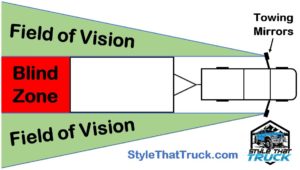
Visibility & Safety
The most important reason you need towing mirrors when towing a trailer is for visibility and safety. You want to see as much of the roadway behind you and your trailer on both the driver’s side and passenger’s side to reduce the possible areas of blind spots or blind zones. This is especially true when you are towing taller trailers like an rv or camp trailer, an enclosed cargo trailer, a tall boat, etc. Towing mirrors will reduce the blind spot areas on either side of the road behind you and along the sides of your trailer. This will help you stay much safer out there as it will be much easier for you to spot other vehicles or motorcycles that would otherwise be in your blind zones. Towing mirrors will also help you to see better down the sides of your trailer as you back it into tight spaces to avoid hitting other objects.
Although no type of side mirror will be able to see the area directly behind a tall trailer, towing mirrors are able to reduce you blind spot area because they stick out farther from the sides of the tow vehicle than standard mirrors do. This allows them to take in a much larger area of the road behind you and beyond the sides of your trailer.
Let’s say your tow vehicle is 70 inches wide between the driver and passenger side windows, as my 3/4 ton pickup truck is. If you have standard mirrors that stick out 12 inches beyond the side windows, the width from outer edge to outer edge of your mirrors would be 94 inches (7 feet 10 inches) and probably about 84 inches (7 ft) between the center view point of each of those two mirrors. If you are towing a trailer that is wider than about 7 feet, your standard mirrors won’t be wide enough to see the area of the road straight down either side of the trailer. There will be a blind spot beginning at the front corners of the trailer that widens out the further behind the side of the trailer you are trying to see as was illustrated earlier in this article.
The factory style towing mirrors for my truck are extendable. When collapsed (not extended), the outer edges stick out 18 inches beyond the side windows, giving a total width from mirror edge to mirror edge of about 106 inches (8 feet 10 inches). The width between the center view point of these towing mirrors when collapsed is about 98 inches (8 feet 2 inches). So, even when collapsed, the towing mirrors for my truck can see down past the sides of a trailer that is more than a foot wider than I could with standard mirrors. Extended, the edge of these same towing mirrors stick out about 22 inches from the side windows with the center view point being about 18 inches out from the window. This gives an outer edge to outer edge extended width of 114 inches (9 feet 6 inches) and about 106 inches (8 feet 10 inches) between the center view point on these mirrors. In other words, towing mirrors greatly increase the field of vision down past the sides of your wider trailers.
Towing Mirror Options
As briefly mentioned in the previous paragraph, many trucks come with a factory style OEM (Original Equipment Manufacturer) extendable towing mirror package. However, what do you do if you don’t have factory extendable towing mirrors on your truck or tow vehicle?
For most trucks built in the last two decades, you can purchase the OEM extendable towing mirrors or a good aftermarket OEM replacement that is a direct fit for you truck as seen in the pictures below. These should be able to be swapped straight out for the standard mirrors with optional plug and play power mirror controls, defrosters, turn signal indicators, etc. This will likely require you to remove your interior door panels to get the job done.
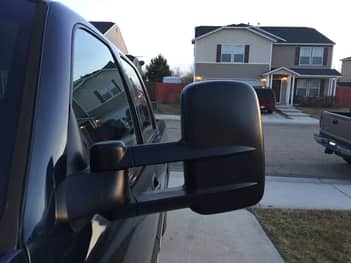
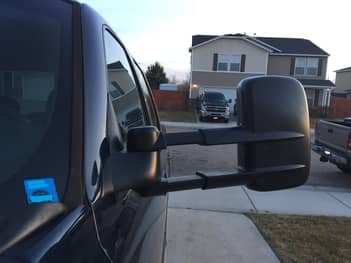
For those vehicles that don’t have direct replacement towing mirrors available or if you don’t want to have that wide and large of a mirror attached at all times, there are many aftermarket towing mirror options that attach and stick out from your standard mirrors when you need them, but which can be removed when you don’t need them.
There are several types of non-permanent aftermarket towing mirrors. They include but aren’t limited to clamp on styles, wrap around slide on styles, clip on styles, and ratchet mount styles to name a few. The clamp on styles are probably the most universal as they generally consist of a mirror attached to the end of a rod like arm. The arm attaches to the top or bottom lip of your side mirror housing using fulling adjustable clamps that tighten down, often without the need for any tools, sticking out beyond the outer edges of the standard factory mirror. This allows the towing mirror to take in a wide view of the road behind you and your trailer. These clamp on styles are universal and will fit almost any factory standard mirror.
The Law
Most states or countries have laws requiring a driver to be able to see a certain distance down the road behind them. Although the exact language and requirements vary from state to state and from country to country, the main purpose of most of these laws seems to be to ensure that drivers can see what is going on behind them. This will help you make the safest and best decisions possible while driving with a trailer.
You should check to know the current laws in your state or country as they can be different or change but here are some examples:
- Many states in the US require mirrors that allow the driver to see 200 feet behind the vehicle
- Some state laws mention a mirror on either side of the vehicle while others do not
- Click here for a state by state list put together by AAA with more detail
- In England, you are required to be able to see a field of vision that is 4 meter wide out from the side of your trailer (just over 13 ft) a distance of 20 meters behind the driver (just over 65.5 ft)
Trailer Height
Some trailers are shorter so that they don’t completely block your vision out your center mounted rear view mirror and you can see much more of the road behind you, even if you do not have towing mirrors. However, there is still a benefit to using towing mirrors on these shorter trailers.
Towing mirrors will help you to see up and down the side of the trailer itself, even if it isn’t tall, allowing you to keep an eye on things and any potential hazards that may be arising from off the trailer itself. This includes being able to visually monitor the wheels and tires of the trailer which can help you to detect low or failing tires, sloppy wheel bearings, etc.
Related Questions
How do you adjust towing mirrors? You want to adjust them so that you can, as best as possible, see a line of sight that runs straight down the side of the trailer 200 feet behind you and out to the sides about a lane’s width or more on either side of the trailer.
Do I need towing mirrors for every trailer? You need mirrors that allow you to see beyond the sides of the trailer to the rear. Towing mirrors almost always make it better but if you are able to see 200 feet behind you on either side without blind spots while using your standard mirrors, you are probably OK.
